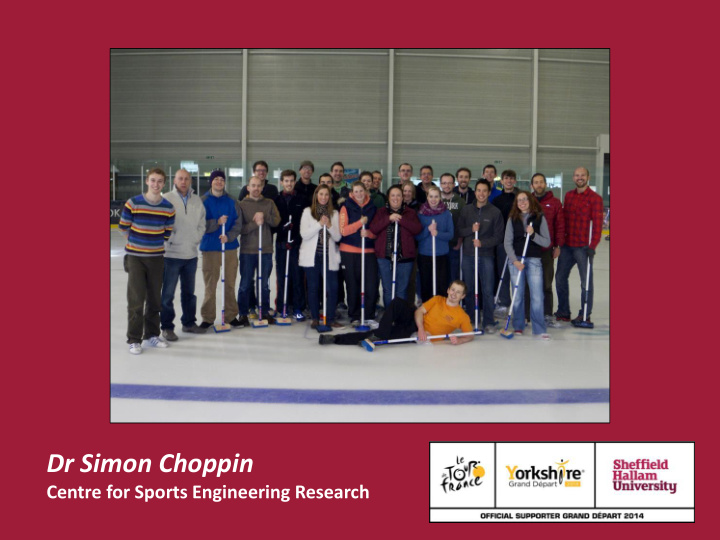



Dr Simon Choppin Centre for Sports Engineering Research
Engineering Retrieved from Wikipedia 11-09-2014 Engineering (from Latin ingenium , meaning "cleverness" and ingeniare, meaning "to contrive, devise") is the application of scientific, economic, social, and practical knowledge in order to invent, design, build, maintain, and improve structures, machines, devices, systems, materials and processes. How can we apply this to sport?
Sports Engineering
categorization of sports technology sporting goods Information-technology (IT) based materials for sporting goods applications & services in sport IT procedures for training-, game- sport equipment and competition analysis (including the mobile equipment of sport facilities) hardware for sport information systems software for sport information systems sport garment / apparel IT procedures for motion analysis sport foot wear & sport surfaces IT procedures for performance prediction personal protection gear Sports Engineering Computer Science in Sports
Sheffield and Hallam University
A brief history of Sports Engineering in Sheffield • ISEA established in 1996 through a conference hosted by Steve Haake in Sheffield. • Under his leadership the Sports Engineering Research Group was started in 1998 • In 2006 the group moved Universities, later becoming The Centre for Sports Engineering Research • The centre currently contains: – 18 full-time researchers – 16 PhD students – 14 MSc students 6
Our partners…
Olympic partners…
Our skills
Skeleton bobsled
Skeleton bobsled
Skeleton bobsled Team GB Team GB Amy Williams Olympic Gold 2010 Lizzy Yarnold Olympic Gold 2010
World's fastest sledge with Guy Martin
World's fastest sledge with Guy Martin
85.6 mph 137.8 km/h
Tennis
Impact modelling
Ball aerodynamics / trajectory modelling
Impact modelling
Tennis GUT
Mobile digital technologies
Scanning with depth cameras Health Elite Sport
What it is…
About the ISEA • 1998 Professor Steve Haake set up the International Sports Engineering Association. • ISEA serves the growing community of sports engineering academics and industries. • Promotes the field through sharing information between members, publication of a journal, support of the biennial conference and support of educational activities.
ISEA Membership 47 23 74 1 1 0! 12
Website: www.sportsengineering.org • Online membership • Information for students and industry • Members only area • Forum (coming soon) • Quarterly newsletter • Access to journal papers • News and events
Journal • Founded in 1998 • Longest running journal in field of Sports Engineering and Technology • Editor: Lloyd Smith • Associate editors: – Tom Allen – Simon Choppin • 4 issues per year • Guest edited special issues • ISI application expected by end of 2014
Stand ndout out papers s (more ore than 20 total tal citati ation ons) s) Cross, R. (1998) The sweet spots of a tennis racket. 38 citation ions Fleisig, G.S., Zheng, N., Stodden, D.E & Andrews, J.R. (2002) Relationship between bat mass properties and bat velocity. 64 64 citatio tions Carré, M.J., Asai, T., Akatsuka, T. & Haake, S.J. (2002) The curve kick of a football, II: flight through the air. 90 citations ions Asai T, Seo K, Kobayashi O, Sakashita R (2007) Fundamental aerodynamics of the soccer ball. 63 63 citatio tions MacKenzie SJ, Sprigings EJ (2009) Understanding the role of shaft stiffness in the golf swing. 28 28 citat ations ions Evan Stuart Walsh, Philippe Rousseau, Thomas Blaine Hoshizaki (2011) The influence of impact location and angle on the dynamic impact response of a Hybrid III headform. 20 citat ations ions
Summer and Winter Schools • Summer school 2009: Chemnitz • Winter school 2011, 2012, 2013 and 2014: San Vito di Cadore (Cortina, Italy)
Conferences • ISEA has administrated a biennial conference since 1996. • Truly international with host institutions from Sheffield, Sydney, Kyoto, California, Munich, Biarritz, Vienna and Lowell. • 2016 conference will be hosted by Delft University of Technology in Netherlands
Opportunities in Sports Engineering
World course database http://www.sportsengineering.org/students/university-courses/
International Sports Engineering Association careers http://www.sportsengineering.org/careers/
MSc Sports Engineering http://www.shu.ac.uk/prospectus/course/900/
MSc Sports Engineering at Sheffield Hallam University Semester 1 modules (all 15 credits) Research methods Computer Mechanics of Numerical Measurement simulation in sports programming in techniques in sport equipment sports engineering sports engineering and biomechanics Semester 2 modules (all 15 credits) Data analysis Human factors in Innovation and enterprise in sports Physiology in sport sports engineering and exercise engineering Year long modules... 45 credit project (industry linked) End of year conference Plus... Personal tutor (focusing on academic and career development) 2 * CSER 6 month paid internship for top students at graduation
Career destinations from MSc Sports Engineering (n = 58) Non-sport, non- technical Elite sport 7% 16% Non sport technical 10% Health 3% Sports industry (governance) 7% Sports indusrty (commercial) PhD 16% 29% University research (sport) 12% 36
PhD Opportunities • Brazilian Science without Borders scheme – Provides financial support for Post-graduate, PhD study around the world. – Sheffield Hallam University is a participating University The Centre for Sports Engineering Research is looking for PhD students Example projects: • 3D scanning for sport and health applications • Tennis racket tracking with cameras for coaching and equipment testing • Wearable sensor technologies for training and injury prevention
Thank you for listening • If you would like more information about – MSc course – PhD opportunities • Contact me: (Dr Simon Choppin) at: s.choppin@shu.ac.uk
Recommend
More recommend